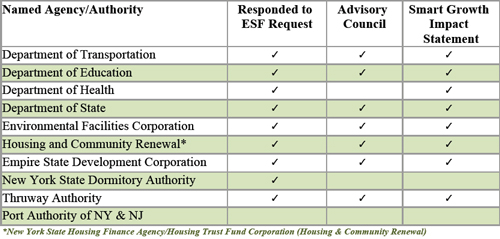In 2010, Albany passed an important bill that directed state agencies to make infrastructure spending decisions in accordance with smart growth principles, but observers cautioned that the legislation’s success hinged on robust implementation.
A recently released report examines just that issue. Empire State Future’s “Smarter Growth: The Implementation of the Smart Growth Public Infrastructure Policy Act” summarizes the results of a series of exchanges with state agencies and authorities, during which the report’s authors asked officials about their progress in implementing the legislation (known as PIPA).
PIPA calls for a smart growth impact statement (SGIS) to accompany public infrastructure projects, a document that outlines the project’s adherence to relevant smart growth criteria delineated in the law. The law also requires the creation of smart growth advisory committees at state infrastructure agencies.
While many agencies have taken these steps (see chart below), the report also found that some “have clearly not done enough to utilize the policy for efficient and effective infrastructure decisions” (for further details on different agencies’ PIPA implementation measures, refer to the report’s appendix [pdf]). In illustrating the wide range of SGIS documents, Empire State Future noted the Tappan Zee Bridge replacement project’s SGIS for its brevity, contrasting the short, much–maligned document with a twelve-page statement that accompanied a manufacturing plant in western New York.

Among agencies that have completed SGIS statements, there has been a “lack of uniformity on when the smart growth impact statement is developed.” Although the law holds that the SGIS must be completed “before making any commitment, including entering into an agreement or incurring any indebtedness,” Empire State Future found that making the SGIS an early part of a given project—when it could still be strengthened through the incorporation of smart growth principles—would be beneficial.
The report also noted that “direct attention from the Administration in the implementation of the law” would benefit the state and called for further action, offering several “next steps”:
- Issue a directive from Commissioners as well as the Governor and his Secretaries to the named agencies to produce the required Smart Growth Impact Statement and Smart Growth Advisory Council;
- Expand further Department of State-led education and guidance on PIPA;
- Provide additional incentives for implementation and disincentives when there is a lack of compliance;
- Advance new legislation that extends PIPA to the tax-credit activities of the Economic Development agencies and better defines “public infrastructure;”
- Direct the Regional Economic Development Councils to voluntarily adhere to PIPA;
- ESF will convene state agencies and authorities tasked with implementing PIPA to improve coordination and accelerate the sharing of best practices.

[…] Report: State DOT Adhering to Smart Growth Law, Port Authority Ignoring It (MTR) […]
[…] which was passed to encourage sustainable development instead of sprawl. An Empire State Future report on PIPA implementation released earlier this year found that New York State would benefit from […]